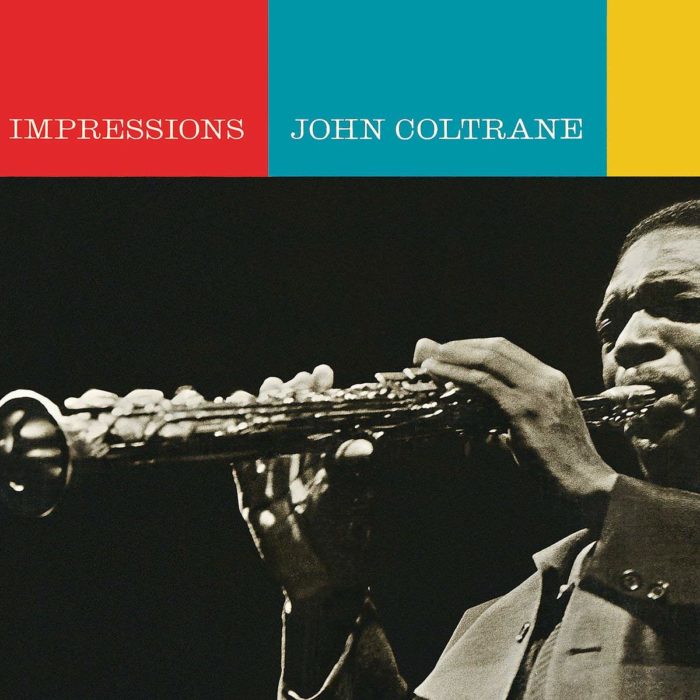
It only seems fitting that the first step on our musical journey begins with a track closely connected to the name of our blog – ‘Impressions’ by the great John Coltrane.
‘Impressions’ is one of four tracks from the album of the same name released on Impulse! records in 1963. The track itself is a live recording of a session at The Village Vanguard, a famous jazz club in New York, on 5 November 1961. On ‘Impressions’, we see Coltrane’s Classic Quartet lineup: John Coltrane soloing on tenor sax, McCoy Tyner accompanying on keys, with Jimmy Garrison holding it down on bass and Elvin Jones keeping military timing on drums. Eric Dolphy also makes a very brief appearance on alto sax but only on the last chord of the song! The track itself, clocking in at around 15 minutes in length, focuses on an epic solo from Coltrane and sees him further exploring the possibilities of a modal approach to music-making, a path he would end up pursuing until the end of his career.
Modal jazz simply defined is an approach to composition which uses musical modes and modulation between those modes instead of relying on a tonal centre. The bebop and hard bop sounds of the 50s that preceded modal jazz had relied on musicians improvising over set chord progressions. Over time, this became limiting to musicians and where they could take their solos. Modal jazz reduced the number of chords in a piece but in the process opened things up melodically and harmonically which gave musicians greater freedom in regards to improvisation. Modal jazz was pioneered in the late 50s, most notably by Miles Davis on his albums Kind of Blue (1959) and Sketches of Spain (1960) (arranged by the fantastic Gil Evans), and in the work of bassist Charles Mingus, most notably on his albums Pithecanthropus Erectus (1956) and The Clown (1957). Coltrane was one of the key players on Miles’ Kind of Blue which was one of the first albums to explore modal composition. All but one of the tracks on the album were recorded in one take and the album went on to become the best-selling jazz record of all time. Interestingly, Coltrane originally called his track ‘So What’ after the famous track from Kind of Blue because he couldn’t come up with a name for it. This was no doubt a nod to one of the main inspirations behind the track that we now know to be ‘Impressions’.
Inspired by his work with Miles, as well his studies under the great jazz pianist Thelonious Monk and free jazz pioneer Ornette Coleman, Coltrane further explored the possibilities of a modal approach, a path which he followed until his passing in 1967. During this time, Coltrane released numerous albums which are now considered historic landmarks of jazz: Giant Steps (1960), My Favorite Things (1961), Africa / Brass (1961), Impressions (1963) and A Love Supreme (1965). Coltrane had become increasingly interested in non-Western musical traditions, studying music from the Middle East, India and Asia. Eastern music often makes use of modes which is no doubt why it was such an interest to Coltrane and other musicians who were exploring the modal sound. The famous pianist Bill Evans who played alongside Coltrane and Miles on Kind of Blue mentioned the influence of meditation and zen on his music. The impact of Coltrane’s work was even felt outside of the jazz sphere, especially on the psychedelic rock bands of the time such as The Byrds and The Grateful Dead. In the same way Coltrane and his group would stretch out and solo for long periods, The Grateful Dead and other psychedelic bands of the late 60s took a similar improvised approach. The close link between the spiritual and the psychedelic is a theme that we will no doubt explore in future posts.
The early 60s were a transitional period for Coltrane as he moved away from the older musical framework of bebop and towards a new modal future. A year after Impressions was released, Coltrane recorded what many would argue is one of the greatest jazz recordings ever made – A Love Supreme, Coltrane’s spiritual offering and prayer to God. From that point on, Coltrane kept pushing further into the outer reaches of jazz and the ripples of this are still being felt throughout music today. Since its release in 1963, the track ‘Impressions’ has gone on to become a well-known jazz standard and has been covered many times by other jazz musicians. My favourite version is McCoy Tyner’s off of his album Trident (1975). It may sound sacrilegious but I actually prefer this version to Coltrane’s original! However, not to dedicate our first post to the original would have been disrespectful to Coltrane and the legacy he left.
Finally, I’ll leave you with a link to a video of a fantastic live performance of ‘Impressions’ performed by Coltrane and his band. Marvel at McCoy Tyner’s fingers!
If you enjoyed this post and want to stay updated, make sure to subscribe to our Spotify playlist and follow us on Instagram and Twitter!

Great new site! Look forward to the next post from the Cats and all that jazz!